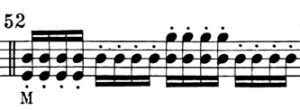Today’s Blog will deal with the last variations on this page of Feuillard’s theme No. 35. Although Feuillard indicates these to be played in the middle of the bow, I prefer to use Variations #52 – #57 to work on a heavy spiccato stroke at the frog. This involves using an active upper arm and a “passive” wrist to create a brushy off-the-string stroke with a very ringy sound. A light version of this stroke might be used in Mozart symphonies or quartets, while the heavier version might be in Wagner or many contemporary works.
Variation #53:
The model for these variations is #53 with its two arm levels, and I like to have the students play this before going sequentially through the other variations (see below).

This stroke is obviously still a “work-in-progress” for Zach – trying to find the relationship between the upper arm and the wrist, and finding the evenness of the stroke.
Variation #52 – #57:





The basic stroke for these variations is the same as for #53. The main technical issues for this stroke are:
- active upper arm, passive (“floppy”) wrist
- close to frog
- “brushy off-the-string” stroke (a heavy spiccato)
- a very ringy sound
- attention to the bow angle (most students will have the tip of the bow pointed too far up at first)
- start above the string, but make sure the bow is on the string before the bow moves
- finding the right height of the stroke so that it is even. If the height varies then the stroke will be un-even because it will take a different amount of time to come down from the air onto the string.
- Variations #52 and #57 require 3 arm levels (upper arm), while the others require only 2 arm levels.
Variations #58 and #59:


These are the final two variations in No. 35. They are three-note chords. Variation #58 is played with all down-bows as two double-stops, or they can be arpeggiated more slowly. However the top note(s) should be on the beat. The bottom notes are played as almost grace-notes before the beat. In other words, if one were playing with a piano, the pianist would play on the downbeat with the top notes of the chord. For example, the opening chords of the Elgar concerto are played this way.
If the chords are played quickly then there isn’t much time to change the contact point (higher c.p. for the lower strings; lower c.p. for the higher strings), but the bow angle should be quite acute so that the contact point is lower on the upper strings. Otherwise the sound will not be good on the A-string.
Variation #59, the last variation on this page, can be executed in two ways:
1) starting both the down-bows and the up-bows from above the string – which means lifting slightly and re-articulating the up-bows so that the articulation is identical with the down-bow. In this case the bow must still be “on” the string a split-second before moving – otherwise it won’t catch the string.
2) starting both up- and down- bows from the string. Both versions require a “figure-eight” in the arm.
Zach demonstrated both versions in the video.
With this Blog we conclude the Theme and Variations No. 35. I would like to thank Zach for having agreed to be featured in these videos as he worked on these variations.
Next week’s offering will feature a blog on teaching collé, before starting the last page of Feuillard exercises. I often wait with teaching collé because students are sometimes confused between using the fingers for the vertical motion of string crossings as opposed to using them for the horizontal motion of collé. Feuillard No. 36 will be dealing with string crossings over four strings. My pre-college student George will be working on collé and then on Feuillard No. 36 with the associated variations.
*If you have questions or comments about The Joy of Feuillard, Dr. Robert Jesselson can be reached directly at rjesselson@mozart.sc.edu.














